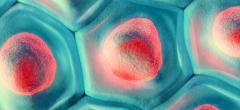Topics
Research reveals defective transport of lysosomal enzymes causes a type of Batten disease

Neuronal Ceroid Lipofuscinoses (NCLs a.k.a. Batten disease) are a group of fatal neurodegenerative disorders that result from defective lysosomal function due to mutations in different CLN genes. A surprising discovery from the laboratory of Dr. Marco Sardiello, assistant professor at Baylor College of Medicine and investigator at the Jan and Dan Duncan Neurological Research Institute at Texas Children’s Hospital shows defective lysosomal biogenesis as the underlying cause of Neuronal Ceroid Lipofuscinoses 8 (NCL8).
In this seminal study published in Nature Cell Biology, researchers have revealed an unanticipated role for CLN8 protein as a cargo receptor that is essential for the proper maturation and transport of lysosomal enzymes from the endoplasmic reticulum (ER) to the Golgi complex, two compartments of the cell that are involved in protein synthesis, modification and distribution. This is the first study to describe the mechanism by which lysosomal enzymes are transported between the ER and the Golgi. In addition to revealing the mechanism of a fundamental cellular process, this study opens up potentially new therapeutic approaches for a particular type of Batten disease.
“When we started working on this lysosomal storage disorder a few years ago, we were baffled by why patients with mutations in CLN8 gene, which was expressed in a distant cellular compartment, the endoplasmic reticulum, developed this neurological condition. This degenerative disorder is seen in children and adults, and is characterized by severe seizures, loss of vision and speech, and decline in motor movements and cognition and leads to premature demise,” said Sardiello.
The lysosomes are sac-shaped recycling centers that clear waste from all cells. These structures contain many enzymes that degrade cellular macromolecules into their constituent components, which the cell can then reuse or discard. When lysosomes fail and cellular waste accumulates, it leads to lysosomal storage disorders, many of which manifest predominantly with neurological symptoms. Unlike other cells, once formed, neurons cannot generate new daughter cells and are therefore, particularly susceptible to defects in lysosomal function and accumulation of cellular trash (i.e. defective proteins and other macromolecules).
Like thousands of other proteins, lysosomal enzymes are synthesized and folded into the right configuration in the endoplasmic reticulum (ER), an interconnected network of flattened membrane sacs present in all cells. Newly synthesized enzymes are modified (analogous to adding address labels) and sorted in the Golgi (that acts as a cellular post office) to be sent to the right cellular destinations, i.e. lysosomes in this case.
“While specific mechanistic steps by which lysosomal enzymes are transported from the Golgi to the lysosomes are well understood, virtually nothing was known about the mechanisms by which lysosomal enzymes are transported from the ER to the Golgi. We began this study with the simple premise that similar to later trafficking steps, there might be specific cargo receptors that ensure lysosomal enzymes are properly sorted through the early compartments (i.e. from the ER-to-Golgi) of the so-called “secretory pathway. First, we went about finding putative receptors (cargo dispatchers) in the ER that may bind to lysosomal enzymes (cargo) and facilitate their traffic between the ER and the Golgi. We compared gene expression patterns of ER resident proteins to the genes encoding lysosomal enzymes. We found four candidate receptors whose expression correlated with the lysosomal genes, meaning they are expressed in the right place at the right time.” explained Dr. Alberto di Ronza, former postdoctoral associate in the Sardiello lab and the lead author of the study.
Using a fluorescent technique that is used to validate protein interactions, researchers found CLN8 was the only candidate cargo receptor that was able to bind specifically to two-thirds of lysosomal enzymes. To test if CLN8 was essential for the proper delivery of lysosomal enzymes, they took advantage of a naturally occurring mouse strain in which Cln8 gene does not function properly. These mice carry point mutations producing functionally defective CLN8 protein, which causes Batten disease-like symptoms in these mice. Interestingly, lysosomes of Cln8 mice had lower concentrations of enzymes compared to the lysosomes obtained from wild-type mice, suggesting CLN8 plays a pivotal role in the proper lysosomal delivery of these enzymes.
Further, they showed CLN8 employs the well-studied COPII machinery for anterograde transport of these enzymes from the ER to the Golgi, and the retrograde COPI machinery to traffic empty CLN8 back using special motifs (“tickets”) to recognize the right cargo and transport vehicle.
So, what happens to the lysosomal enzymes stuck in the ER of CLN8-defective cells? As the ‘production factory’ of the cells, the ER is responsible for ensuring only perfectly synthesized and packaged proteins are allowed to transit through the secretory pathway. Defective products (misfolded or mutated proteins) are degraded right away through a cellular quality-control process called the ER-associated protein degradation (ERAD) in specialized organelles called the proteasomes present outside the ER.
Researchers found lysosomal enzymes are specifically degraded at a much faster rate in the proteasomes of CLN8-defective cells than normal cells. Consistent with this observation, various brain regions of Cln8-deficient mice had dramatically lower levels of several lysosomal enzymes, suggesting this is the cause of the severe pathology.
This study has significantly advanced the understanding of how CLN8 causes this particular type of Batten disease. Researchers hope this study will spark the interest of other scientists with diverse expertise and knowledge towards this area of research, which will be crucial to develop treatments for patients suffering from this disorder. In principle, enzyme replacement therapy could be an option to provide NCL patients with the missing enzymes and future studies can test if that could be a viable option in this case.




